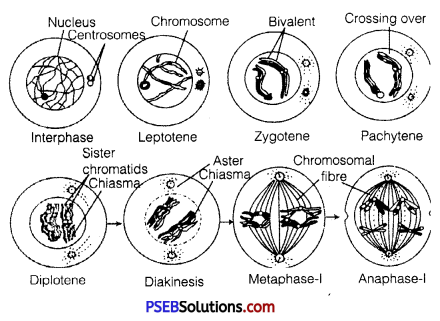Punjab State Board PSEB 11th Class Biology Important Questions Chapter 10 Cell Cycle and Cell Division Important Questions and Answers.
PSEB 11th Class Biology Important Questions Chapter 10 Cell Cycle and Cell Division
Very short answer type questions
Question 1.
During which phase of mitotic cell division, chromosomes gets separated?
Answer:
During anaphase.
Question 2.
Does mitosis occurs before or after the interphase?
Answer:
Yes, mitosis occurs before or after the interphase, as dividing phase (meiosis or mitosis) and interphase are considered only as the major phases of a cell cycle.
![]()
Question 3.
Mitosis cell division helps in regeneration process. How?
Answer:
Mitosis helps in regeneration by keeping all the somatic cells of an organism genetically similar, so that they are able to regenerate part or whole of the organism.
Question 4.
Given that average duplication time of E. coli is 20 minutes. How much time will two E. coli cells take to become 32 cells?
Answer:
2 hours (2n = 25 = 2 × 2 × 2 × 2 × 2 = 32 generations).
Question 5.
If a tissue has 1024 cells at a given time, how many cycles of mitosis had the original parental single cell undergone?
[NCERT Exemplar]
Answer:
10 (2n, where n =10 generations).
Question 6.
Two key events take place during S-phase in animal cells, i.e., DNA replication and duplication of centriole. In which parts of the cell do these events occur? [NCERT Exemplar]
Answer:
DNA replication in the nucleus. Centriole duplication in the cytoplasm.
Question 7.
At what stage of meiosis, formation of tetrads occurs? Name it.
Answer:
Tetrads are formed during pachytene of prophase-I (meiosis-I).
![]()
Question 8.
Meiosis is essential in sexually reproducing organisms. How?
Answer:
Meiosis is essential in sexually reproducing organisms because it keeps the chromosome number constant.
Question 9.
Which cells of our body do not divide?
Answer:
Neuron cells stops dividing soon after the birth of a child.
Question 10.
The diagram shows a bivalent at prophase-I of meiosis. Which of the four chromatids can cross over? [NCERT Exemplar]
Answer:
The non-sister chromatids of homologous pair of chromosome undergo meiosis.

Short answer type questions
Question 1.
Imagine a situation if there was no meiosis. Then what would have happened to the next generation?
Answer:
In the absence of meiosis the next generation would have double the number of chromosomes after fusion of gametes. This would have resulted in the birth of an altogether new species. The maintenance of characters set would have been possible only through asexual reproduction.
Question 2.
Give a description of metaphase I of meiosis.
Answer:
Metaphase I: The bivalent chromosomes align on the equatorial plate. The microtubules from the opposite poles of the spindle attach to the pair of homologous chromosomes.
![]()
Question 3.
Describe telophase I of meiosis.
Answer:
Telophase I
- The nuclear membrane and nucleolus reappear, cytokinesis follows and this is called as diad of cells.
- Although in many cases the chromosomes do undergo some dispersion, they do not reach the extremely extended state of the interphase nucleus.
- The stage between the two meiotic divisions is called interkinesis and is generally short lived. Interkinesis is followed by prophase II, a much simpler prophase than prophase I.
Question 4.
What is the process of cell division in prokaryotes?
Answer:
Prokaryotes do not have nucleus. So, there is no elaborate karyokinesis, as seen in eukaryotes. In prokaryotes the replication of DNA starts the process of cell division. Once genetic material is replicated, it is followed by division of cytoplasm. The process is known as binary fission.
Question 5.
How does meiosis facilitate creation of offsprings, with distinct characters?
Answer:
Meiosis happens during gametogenesis and as a result gametes have half the number of chromosomes. During fertilization, when gametes fuse together two different sets of chromosomes make a new set. This results in an offspring, who has distinct characters, compared to parents.
Question 6.
What is the significance of mitosis?
Answer:
Significance of Mitosis
- In multicellular organisms, body growth is by mitotic divisions of the cells.
- Replacement of worn out tissues/cells (e.g., blood cells, skin cells) and repair of the injured tissues is by mitosis.
- In unicellular organisms, mitosis are involved in asexual reproduction
(multiplication of cells). - In plants, vegetative propagation involves only mitotic divisions and genetically identical individuals are produced.
- Uncontrolled cell divisions in certain tissues/organ (cancer) result in tumours.
![]()
Long answer type questions
Question 1.
Briefly describe the significance of cell division.
Answer:
Cell division is significant in the following ways :
- Cell Multiplication: Cell division is a means of cell multiplication or formation of new cells from pre-existing cells.
- Continuity: It maintains continuity of living matter generation after generation.
- Multicellular Organisms: The body of a multicellular organism is formed of innumerable cells. They are formed by repeated divisions of a single cell or zygote. As the number of cells increases, many of them begin to differentiate, form tissues and organisms.
- Cell Size: Cell division helps in maintenance of a particular cell size which is essential for efficiency and control of cell activities.
- Genetic Similarity: The common type of cell division or mitosis maintains genetic similarity of all the cells in an individual despite being different, i.e., structurally and functionally.
Question 2.
Explain meiosis-II in an animal cell.
Answer:
All these happen in the two haploid nuclei simultaneously.
- Prophase-II: It takes short time. Spindle formation begins and the chromosomes become short. Two chromatids, are joined to a single centromere. Nuclear membrane and nucleolus disintegrate.
- Metaphase-II: At the equator, the chromosomes lie and spindle is formed. The centromere of every chromosomes is joined to the spindle fibre and centromere also divides.
- Anaphase-II: The daughter chromosomes are formed. Chromatids move towards their poles with the spindle fibres.
- Telophase-II: Reaching at the poles, chromosomes form nuclei which are haploid (n) daughter nuclei. Again nuclear membrane is constructed. Nucleolus now becomes clearly visible.
- Cytokinesis: It occurs and four daughter cells are formed which are haploid (n). It may occur once or twice (i.e., in meiosis-I and II) or only after the meiosis-II cell division.
![]()
Question 3.
Describe briefly the phases of meiotic division.
Answer:
Meiotic division takes place in germ cells. The number of chromosomes is reduced to half in daughter cells.
Meiotic cell division is divided into two phases, i.e., meiotic-I and II.
In the meiotic-I division, the homologous chromosomes pair to form bivalent. Exchange of genetic material takes place. The chromosomes now separate and get distributed into daughter cells.
Long prophase-I is divided into five sub-stages, i.e., leptotene, zygotene, pachytene, diplotene and diakinesis. During metaphase-I, the bivalents arrange themselves on equatorial plate with their arms on the plate but the centromere is directed towards opposite pole. It is followed by anaphase-I. Now, the homologous chromosomes repel each other, move to the opposite poles with both their chromatids. In this way each pole gets half the chromosomes number of the parent cell.
In telophase-I, the nuclear envelope and nucleolus again appear. The centromere of each chromosome breaks, separating the chromatids, one each to a daughter cell. The meiotic cell division maintains chromosome number of a species.
As a result of meiotic division, the four daughter cells are formed with half the chromosome number (haploid) in each cell.
